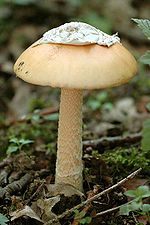- Amanita lanei
-
Amanita lanei 
Amanita lanei Scientific classification Kingdom: Fungi Division: Basidiomycota Class: Agaricomycetes Order: Agaricales Family: Amanitaceae Genus: Amanita Species: A. lanei Binomial name Amanita lanei
(Murrill) Sacc. & TrotterSynonyms Amanita calyptrata
Amanita calyptrodermaAmanita lanei Mycological characteristics 
gills on hymenium 

cap is flat
or convex
hymenium is free 
stipe has a ring and volva 
spore print is white 
ecology is mycorrhizal 

edibility: edible
but not recommendedAmanita lanei (= Amanita calyptrata and Amanita calyptroderma), also known as coccora or coccoli, is a white-spored mushroom that fruits naturally in the coastal forests of the western United States during the fall and winter. A spring form occurs which has a light yellow cap.
Contents
Description
This mushroom is recognized by its large, orange-brown cap partially covered by a thick patch of universal veil, its white gills and spores, its cream-colored stalk adorned with a partial veil, a partially hollow stem (filled with a stringy white pith), and by the presence of a large, sacklike volva at the base of the stalk.
The spores of this species do not change color when placed in a solution of Melzer's reagent, and thus are termed inamyloid. This characteristic in combination with the absence of a bulb at the base of the stalk place this mushroom in the Section Vaginatae.
Classification
Rodham E. Tulloss suggests that there may in fact be several distinct species currently grouped under the name Amanita lanei. For a brief discussion of the confused history behind the species name of this mushroom, read Nathan Wilson's article on A. lanei
Distribution and habitat
This mushroom forms mycorrhizae with Madrone (Arbutus menziesii) in the southern part of its range (Central California northwards to Washington). However, in the northern part of its range (Washington to southern Canada), its preferred host is Douglas Fir (Pseudotsuga menziesii).
Edibility
Experienced mushroom hunters regard this mushroom as a good edible species, but caution must be exercised when collecting A. lanei for the table, since it can be confused with other species in the genus Amanita. This genus contains some of the deadliest mushrooms in the world, most notably A. phalloides, A. ocreata and A. virosa. The spring form of A. lanei is nearly the same color as the A. phalloides and the edible species can be differentiated by its striate cap margin, lack of a true bulb at the base of the stem, volva attachment and inamyloid spores.
See also
External links
Subgenus Amanita Section Amanita- A. altipes
- A. armeniaca
- A. farinosa
- A. frostiana
- A. gemmata
- A. muscaria
- A. nehuta
- A. pantherina
- A. parvipantherina
- A. regalis
- A. rubrovolvata
- A. virgineoides
- A. xanthocephala
Section Vaginatae- A. ceciliae
- A. crocea
- A. fulva
- A. liquii
- A. nivalis
- A. orientifulva
- A. pachycolea
- A. pekeoides
- A. umbrinolutea
- A. vaginata
- A. velosa
Section Caesareae- A. basii
- A. caesarea
- A. chepangiana
- A. hemibapha
- A. jacksonii
- A. lanei
- A. spreta
- A. zambiana

Subgenus Lepidella Section Lepidella- A. abrupta
- A. atkinsoniana
- A. austroviridis
- A. ananaeceps
- A. cokeri
- A. daucipes
- A. magniverrucata
- A. nauseosa
- A. onusta
- A. ravenelii
- A. smithiana
- A. solitaria
- A. thiersii
- A. vittadinii
Section Amidella- A. ovoidea
- A. volvata
Section Phalloideae- A. arocheae
- A. bisporigera
- A. exitialis
- A. magnivelaris
- A. marmorata subsp. myrtacearum
- A. manginiana
- A. ocreata
- A. pseudoporphyria
- A. phalloides
- A. subjunquillea
- A. verna
- A. virosa
- A. virosiformis
Section Validae- A. aestivalis
- A. australis
- A. brunnescens
- A. citrina
- A. excelsa v. spissa
- A. flavella
- A. flavoconia
- A. flavorubens
- A. franchetii
- A. nothofagi
- A. novinupta
- A. porphyria
- A. rubescens
Categories:- Amanita
- Edible fungi
- Fungi of North America
Wikimedia Foundation. 2010.
